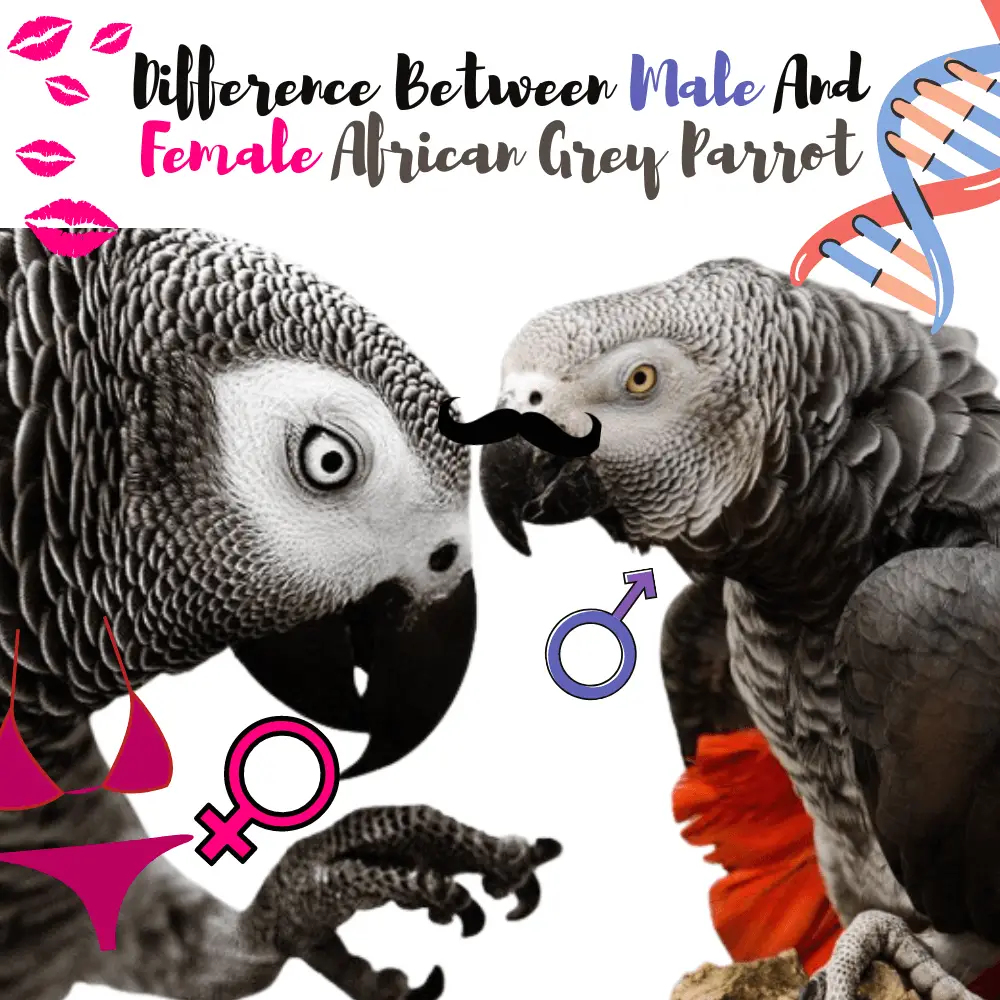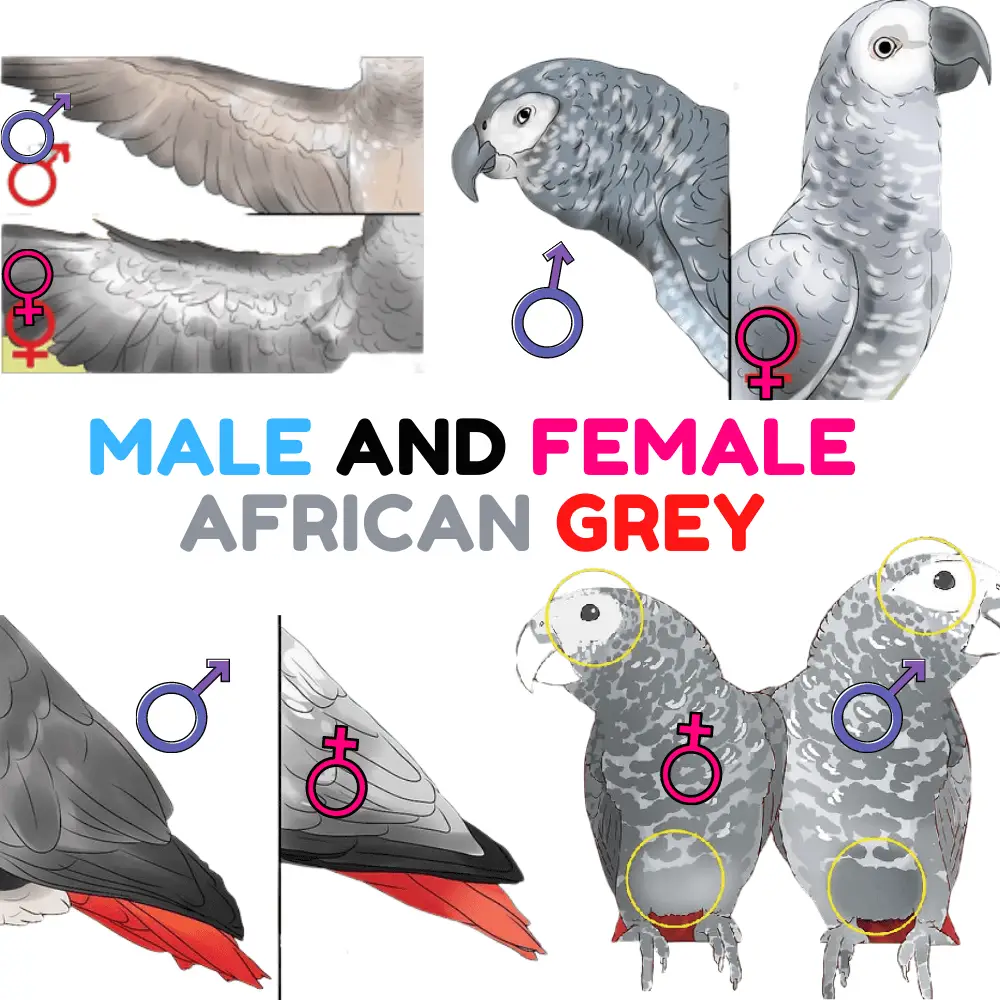
Difference between male and female African grey parrot : How to determine the sex of an African gray parrot? African grey parrots are considered intelligent and popular birds.
It can be helpful to know the sex of your bird if you intend to attend breeding or if you plan to introduce another bird into its cage and want to prevent this from happening. Physically, it is very difficult to determine the sex of African grey parrots, although males and females have some subtle traits that differentiate them.
You should contact a bird veterinarian or opt for a DNA test if you need a definitive answer, as this is the only way to be sure of your bird’s gender.
Observe physical traits
Observe the body. There are slight differences between the type and size of the body of females and males. First, you need to take into account the general body type of the bird to get a clue about its sex. Thanks to this, you can detect more subtle physical traits.
- Males usually measure between 30 and 35 cm while females are a little smaller.
- The body of a male African grey parrot is usually rounded, while that of a female tends to be thinner.
- The male’s head tends to be small and flat, and his neck is shorter. Females usually have a longer neck and a larger, rounder head.
Examinez les couleurs. Les mâles présentent habituellement une couleur plus foncée et plus uniforme que les femelles. En revanche, les femelles ont une coloration dégradée allant du clair au foncé, du cou au ventre .
- Cette technique ne s’applique qu’aux perroquets de plus de 18 mois. Les plumes d’un bébé perroquet n’ont pas encore complètement poussé et changeront de couleur avec le temps.
Examinez les plumes de la queue. En général, les mâles ont des plumes de couleur plus foncée que celles des femelles. Vous devez vérifier les plumes ventrales. Il s’agit d’un ensemble d’environ dix plumes qui se trouvent directement sous la queue de l’oiseau. Tenez l’animal et tournez-le doucement pour observer ces plumes.
- Les femelles ont des plumes ventrales grises tandis que celles des mâles sont rouges. Dans certains cas, vous pourriez voir un petit trait blanc dans les plumes des mâles.
- Vous devez comprendre que la précision de ce test n’est pas garantie chez les plus jeunes perroquets. Vous ne devez pas vous fier uniquement aux plumes de la queue pour déterminer le sexe à moins que l’oiseau ait plus de 18 mois.
Check the wings. Watch the bird flapping its wings. You must be able to notice three gray stripes at the bottom of the wings. The colors of these traits are slightly different in both sexes.
- In females, the first stripe is usually white, the second gray, and the third dark gray. In males, the first and second are usually gray and the third is dark gray.
- This difference is very small and can be difficult to detect. You also need to observe other physical traits of the bird (in addition to the color of its wings) to determine its sex.

Consult the experts
Look for a reputable bird specialist in your area. Specialists are professional veterinarians whose main focus is birds. The Bird And You website provides you with a list of avian veterinarians, classified by the department.
- You also have the option to search online by writing about avian veterinarians in [your city or country].
- If you have other pets, you can check with their respective veterinarians. They can refer you to a specialist or do blood tests or DNA tests themselves in their office.
- Make sure the doctor is certified or a member of the National Order of Veterinarians. He must also provide you with the documentation that proves this.
Ask the avian veterinarian to determine the sex. Veterinarians can perform laboratory tests on the bird to determine its sex. Bringing the animal to the vet just to determine its sex can be expensive. Nevertheless, you may need to know this detail. If you want to have baby parrots, you will need a male and a female. If you want to get another African grey parrot, but want to avoid breeding, you need to make sure that both are of the same sex or have them castrated.
- Usually, veterinarians perform an endoscopy to determine sex. This procedure involves the use of a fiberscope to examine the bird’s internal organs.
- In addition, the veterinarian may perform other laboratory tests. The examination he chooses will depend on the medical history and overall health of the parrot. So you need to discuss all the options with him.
Do a DNA test at home. This type of test is used to determine the sex of the bird and tends to be less invasive. Surgical and laboratory tests can often harm the health of the bird. You have the option of getting a home DNA test kit or blood collection tool. The sample will then be sent to a laboratory that will perform the test and send you the results. These kits are easy to assemble and use.
- DNA testing can be performed with nail tips, eggshells, or feathers torn off the animal’s body. These elements will give results as accurate as those of a blood sample.
- Talk to the vet to see if they can offer you this kit. However, you must ensure that you obtain a document that certifies the accuracy of this test.
- You should know that feathers collected directly from the animal’s body (not those it has lost) contain enough genetic information to obtain an accurate result.
- In general, the results of these tests are obtained quickly, as they only take between two and three working days. In addition, the test kit costs about 25-20 $.
Warnings
- You should always be careful when handling these birds. African grey parrots can cause serious damage when frightened or upset. So wait for the bird to calm down and feel comfortable with you before you start touching it.
- DNA testing is the only way to determine the sex of your African grey parrot with 100% accuracy.
African Grey See Diff Male Vs Female
SOURCE:Parrot Bliss




















